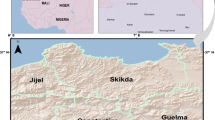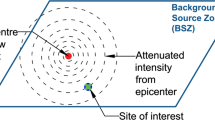Abstract
Modern Earthquake Risk Assessment (ERA) methods usually require seismo-tectonic information for Probabilistic Seismic Hazard Assessment (PSHA) that may not be readily available in developing countries. To bypass this drawback, this paper presents a practical event-based PSHA method that uses instrumental seismicity, available historical seismicity, as well as limited information on geology and tectonic setting. Historical seismicity is integrated with instrumental seismicity to determine the long-term hazard. The tectonic setting is included by assigning seismic source zones associated with known major faults. Monte Carlo simulations are used to generate earthquake catalogues with randomized key hazard parameters. A case study region in Pakistan is selected to demonstrate the effectiveness of the method. The results indicate that the proposed method produces seismic hazard maps consistent with previous studies, thus being suitable for generating such maps in regions where limited data are available. The PSHA procedure is developed as an integral part of an ERA framework named EQRAM. The framework is also used to determine seismic risk in terms of annual losses for the study region.
Similar content being viewed by others
References
Abrahamson Norman A (2000), “State of the Practice of Seismic Hazard Evaluation,” Proceedings of the CeoEng2000 conference, Melbourne, Australia, 19–24 November.
Abrahamson Norman A (2006), “Seismic Hazard Assessment: Problems with Current Practice and Future Developments,” Proceedings of the 1st European Conference on Earthquake Engineering and Seismology, Geneva, Switzerland (in CD).
Ahmad Soheib, Khan Shaukat Ali, Pilakoutas Kypros and Khan Qaiser Uz Zaman (2015), “Empirical Vulnerability Assessment of the Non-Engineered Reinforced Concrete Structures using the Kashmir Earthquake Damage Data,” Bulletin of Earthquake Engineering, 13(9): 2611–2628.
Algermissen Sylvester Theodore and Perkins David M (1972), “A Technique for Seismic Zoning—General Considerations and Parameters,” Proceedings of the 1st International Conference on Microzonation, Seattle, Washington, 865–878.
Ali Qaisar and Khan Akhtar Naeem (2005), “A Critical Review of the Seismic Hazard Zoning of Peshawar and Adjoining Areas,” Journal of Earthquake Engineering, 9(05): 587–607.
Ambraseys Nicholas Neocles, Douglas John, Sarma Sarada K and Smith Patrick M (2005), “Equations for the Estimation of Strong Ground Motions from Shallow Crustal Earthquakes Using Data from Europe and the Middle East: Horizontal Peak Ground Acceleration and, Spectral Acceleration,” Bulletin of Earthquake Engineering, 3(1): 1–53.
Assatourians Karen and Atkinson Gail M (2013), “EqHaz: An Open-Source Probabilistic Seismic-Hazard Code Based on the Monte Carlo Simulation Approach,” Seismological Research Letters, 84(3): 516–524.
BCP-Building Code of Pakistan (2007), Building Code of Pakistan Seismic Provisions (SP-2007), Ministry of Housing and Works, Government of Pakistan, Islamabad.
Beauval Celine, Scotti Oona and Bonilla Fabian (2006), “The Role of Seismicity Models in Probabilistic Seismic Hazard Estimation: Comparison of a Zoning and a Smoothing approach,” Geophysical Journal International, 165(2): 584–595.
Bender Bernic and Perkins David M (1987), SEISRISK III: A Computer Program for Seismic Hazard Estimation, USGS Bulletin 1772, US Government Printing Office, Washington.
Ben-Naim Eli, Daub Eric G and Johnson Paul A (2013), “Recurrence Statistics of Great Earthquakes,” Geophysical Research Letters, 40(12): 3021–3025.
Bommer Julian J (2002), “Deterministic vs. Probabilistic Seismic Hazard Assessment: an Exaggerated and Obstructive Dichotomy,” Journal of Earthquake Engineering, 6(spec01): 43–73.
Bommer Jualian J and Scherbaum Frank (2008), “The Use and Misuse of Logic Trees in Probabilistic Seismic Hazard analysis,” Earthquake Spectra, 24(4): 997–1009.
Burke Robert (2003), Getting to know ArcObjects: Programming ArcGIS with VBA, Environmental Systems Research Institute, Inc., Redlands, CA, USA.
Burton Paul and Cole Simon W (2006), “Pakistan Earthquake 2005 October 8: Earthquake Expectation and Seismic Hazard Through to Impact,” Proceedings of the 1st European Conference on Earthquake Engineering and Seismology, Geneva, Switzerland (in CD).
Coburn Andrew and Spence Robin (1992), Earthquake Protection, John Wiley and Sons Ltd., Chichester, UK.
Cornell C Allin (1968), “Engineering Seismic Risk Analysis,” Bulletin of the Seismological Society of America, 58(5): 1583–1606.
Cornell C Allin (1971), “Probabilistic Analysis of Damage to Structures under Seismic Loads,” in Howells DA, Haigh IP and Taylor C (editors), Dynamic Waves in Civil Engineering, New York, Wiley-Interscience, 473–493.
Cornell C Allin and Vanmarcke Erik H (1969), “The Major Influences on Seismic Risk,” Proceedings of the 4th World Conference on Earthquake Engineering, Santiago, Chile, 1: 69–83.
Crowley Helen and Bommer Julian J (2006), “Modelling Seismic Hazard in Earthquake Loss Models with Spatially Distributed Exposure,” Bulletin of Earthquake Engineering, 4(3): 249–273.
Der Kiureghian Armen and Ang Andrew H (1977), “A Fault-Rupture Model for Seismic Risk Analysis,” Bulletin of the Seismological Society of America, 67(4): 1173–1194.
FBS-Federal Bureau of Statistics (2007), Government of Pakistan, Islamabad, Pakistan, at http://www.statpak.gov.pk/depts/index.html (Accessed on 9th December 2007).
Field Edward H, Jordan Thomas H and Cornell C Allin (2003), “OpenSHA: A Developing Community-Modeling Environment for Seismic Hazard Analysis,” Seismological Research Letters, 74(4): 406–419.
GEM (2011), Global Earthquake Model, https://www.globalquakemodel.org/
GESI (2001), “Global Earthquake Safety Initiative, Pilot Project, GeoHazards International (GHI),” United Nations Centre for Regional Development, Final Report, June 2001.
GSP (Geological Survey of Pakistan (GSP) (2006), Seismic Hazard Map of Pakistan, Geological Survey of Pakistan, Government of Islamic Republic of Pakistan, Islamabad, Pakistan.
GSP (Geological Survey of Pakistan) Geological Survey of Pakistan (GSP) (2009), Seismic Hazard Map of Pakistan, Geological Survey of Pakistan, Ministry of Petroleum and Natural Resources, Islamabad, Pakistan.
Hanks Thomas C, and Cornell C Allin (1994), “Probabilistic Seismic Hazard Analysis: A Beginner’s Guide,” Proceedings of the 5th Symposium on Current Issues Related to Nuclear Power Plant Structures, Equipment and Piping, North Carolina State University, Raleigh, USA.
Hayat Khizar (2003), “Geotechnical Zonation and Their Relation to Geology of Pakistan,” PhD Thesis, Institute of Geology, University of the Punjab, Lahore, Pakistan.
ISC (2009), International Seismological Centre Pipers Lane, Thatcham, Berkshire, RG19 4NS, UK, at http://www.isc.ac.uk/
Jadoon Ishtiaq AK (1992), “Ocean/Continental Transitional Crust Underneath the Sulaiman Thrust Lobe and an Evolutionary Tectonic Model for the Indian/Afghan Collision Zone,” Pakistan Journal of Hydrocarbon Research, 4(2): 33–45.
Javed Mohammad, Khan Akhtar Naeem, Penna Andrea and Magenes Guido (2006), “Behaviour of Masonry Structures During the Kashmir 2005 Earthquake,” Proceedings of the 1st European Conference on Earthquake Engineering and Seismology, Geneva, Switzerland.
Kagan Yan Y (2003), “Accuracy of Modern Global Earthquake Catalogs”, Physics of the Earth and Planetary Interiors, 135(2): 173–209.
Khan Shaukat Ali (2011), “An Earthquake Risk Assessment Framework for Developing Countries: Pakistan Case Study,” PhD Thesis, Department of Civil and Structural Engineering, University of Sheffield, Sheffield, UK.
Kijko Andrzej and Sellevoll Markvard A (1989), “Estimation of Earthquake Hazard Parameters from Incomplete Data Files. Part I. Utilization of Extreme and Complete Catalogs with Different Threshold Magnitudes,” Bulletin of the Seismological Society of America, 79(3): 645–654.
Krinitzsky Ellis L (1993), “Earthquake Probability in Engineering: Part 1. The Use and Misuse of Expert Opinion,” Engineering Geology, 33(4): 257–288.
Krinitzsky Ellis L (2003), “How to Combine Deterministic and Probabilistic Methods for Assessing Earthquake Hazards,” Engineering. Geology, 70(1): 157–163.
Kythreoti Stella (2002), “Earthquake Risk Assessment and Management Case Study: Cyprus,” PhD Thesis, Department of Civil and Structural Engineering, The University of Sheffield, Sheffield, UK.
McGuire Robin K (2004), Seismic Hazard and Risk Analysis, Earthquake Engineering Research Institute, MNO-10, Oakland, CA, USA.
McGuire Robin K (1976), FORTRAN Computer Program for Seismic Risk Calculations, USGS Open-File Report 76–67.
McGuire Robin K (1993), “Computations of Seismic Hazard,” in Giardini D and Basham PW (editors), Global Seismic Hazard Assessment Program, Annals of Geophysics, 34: 181–200.
McGuire Robin K (2001), “Deterministic vs. probabilistic earthquake hazards and risks,” Soil Dynamics and Earthquake Engineering., 21: 377–384.
Mulargia Francesco, Stark Philip B and Geller Robert J (2017), “Why is Probabilistic Seismic Hazard Analysis (PSHA) still used?,” Physics of the Earth and Planetary Interiors, 264(March 2017): 63–75.
Mulyani Rini (2013), “Extended Framework for Earthquake and Tsunami Risk Assessment: Padang City as a case study,” PhD Thesis, Dept. of Civil & Structural Engineering, The University of Sheffield, UK.
Musson Roger MW (1999), “Probabilistic Seismic Hazard Maps for the North Balkan Region,” Annals of Geophysics, 42(6): 1109–1124.
Musson Roger MW (2000), “Generalised Seismic Hazard Maps for the Pannonian Basin Using Probabilistic Methods,” Pure and Applied Geophysics, 157(1-2): 147–169.
NHA (2009), National Highway Authority, NHA HQ, 27, Mauve Area, G-9/1, Islamabad, Pakistan.
NHSM-National Seismic Hazard Maps (2008), United States Geological Survey, Open-File Report, 2008–1128.
Oliveira Carlos Sousa and Campos Costa Alfredo (2006), “Overview on Earthquake Hazard Assessment -Methods and New Trends”, in Oliveira CS, Roca A and Goula A (editors), Assessing and Managing Earthquake Risk, Springer, 15–46
Ordaz Mario, Aguilar Armando and Arboleda Jose (2003), Crisis 2003 Ver. 3.01, Program for Computing Seismic Hazard, Available at http://www.iingen.unam.mx.
PMD-NORSAR (2007), “Seismic Hazard Analysis and Zonation for Pakistan, Azad Jammu and Kashmir,” A Report by: Pakistan Meteorological Department (PMD) and NORSAR-Norway, Islamabad, Pakistan.
Raghu Kanth STG (2008), “Ground Motion Estimation During the Kashmir Earthquake of 8th October 2005,” Natural Hazards, 46(1): 1–13.
RE (2009), Risk Engineering Inc., Website http://www.riskeng.com/ (Accessed on 12th March 2009).
Reiter Leon (1990), Earthquake Hazard Analysis: Issues and Insights, Columbia University Press, New York, USA.
Robinson David and Fulford George (2005), EQRM: Geoscience Australia’s Earthquake Risk Model Technical Manual, Version 3.0, GA Record 2005/01, Geoscience Australia, Canberra.
Shah Haresh C, Dong Weimin, Stojanovski Pane and Chen Alex (2018), “Evolution of Seismic Risk Management for Insurance over the Past 30 Years,” Earthquake Engineering and Engineering Vibration, 17(1): 11–18.
Shapira Avi (1983), “Potential Earthquake Risk Estimations by Application of a Simulation Process,” Tectonophysics, 95(1): 75–89.
Shende VJ, Ramakrishna TVS and Gupta ID (2009), “A non-Poissonian recurrence model for large magnitude earthquakes in Central Himalayan region,” ACSGE-2009, Oct 25–27, BITS Pilani, India.
Sokolov Vladmir, Wenzel Friedemann, Mohindra Rakesh, Grecu Bogdan and Radulian Mircea (2007), “Probabilistic Seismic Hazard Assessment for Romania Considering Intermediate-depth (Vrancea) and Shallow (Crustal) Seismicity,” Proceedings of the Int. Symposium on Strong Vrancea Earthquake and Risk Mitigation, Bucharest, Romania.
Somerville Paul G, Smith Nancy F, Graves Robert W and Abrahamson Norman A (1997), “Modification of Empirical Strong Motion Attenuation Relations to Include the Amplitude and Duration Effect of Rupture Directivity,” Seismological Research Letters, 68(1): 199–222.
Thenhaus Paul C and Campbell Kenneth W (2003), “Seismic Hazard Analysis,” in: Chen W-F and Scawthorn C (editors), Earthquake Engineering Handbook, CRC Press, Boca Raton, FL, 8–1 to 50.
Tothong Polsak, Cornell C Allin, Baker JW. (2007), “Explicit Directivity-Pulse Inclusion in Probabilistic Seismic Hazard Analysis,” Earthquake Spectra, 23(4): 867–891.
USGS (2008), Seismic Hazard of Pakistan, at: http://earthquake.usgs.gov/earthquakes/world/pakistan/gshap.php.
USGS (2009), United States Geological Survey, Earthquake Hazard Program, at http://earthquake.usgs.gov/.
Wells Donald L and Coppersmith Kevin J (1994), “New Empirical Relationships Among Magnitude, Rupture Length, Rupture Width, and Surface Displacements,” Bulletin of the Seismological Society of America, 84(4): 974–1002.
Woo Gordon (1996), “Kernel Estimation Methods for Seismic Hazard Area Source Modeling,” Bulletin of the Seismological Society of America, 86(2): 353–362.
Xie Lili and Qu Zhe (2018), “On Civil Engineering Disasters and Their Mitigation,” Earthquake Engineering and Engineering Vibration, 17(1): 1–10.
Zabukovec B, Motnikar BS and Zupbancic P (2000), OHAZ: A Computer Program for Seismic Hazard Calculation, User Manual, Geophysical Survey of Slovenia, Ljubljana.
Zaigham Nayyer Alam and Mallick Khalil Ahmed (2000), “Bela Ophiolite Zone of Southern Pakistan: Tectonic Setting and Associated Mineral Deposits,” GSA Bulletin, 112(3): 478–489.
Zeiler Michael (1999), Modeling Our World: The ESRI Guide to Geodatabase Design, Environmental Systems Research Institute (ESRI), Redlands, CA, USA.
Author information
Authors and Affiliations
Corresponding author
Rights and permissions
About this article
Cite this article
Khan, S.A., Pilakoutas, K., Hajirasouliha, I. et al. Seismic risk assessment for developing countries: Pakistan as a case study. Earthq. Eng. Eng. Vib. 17, 787–804 (2018). https://doi.org/10.1007/s11803-018-0476-3
Received:
Accepted:
Published:
Issue Date:
DOI: https://doi.org/10.1007/s11803-018-0476-3




